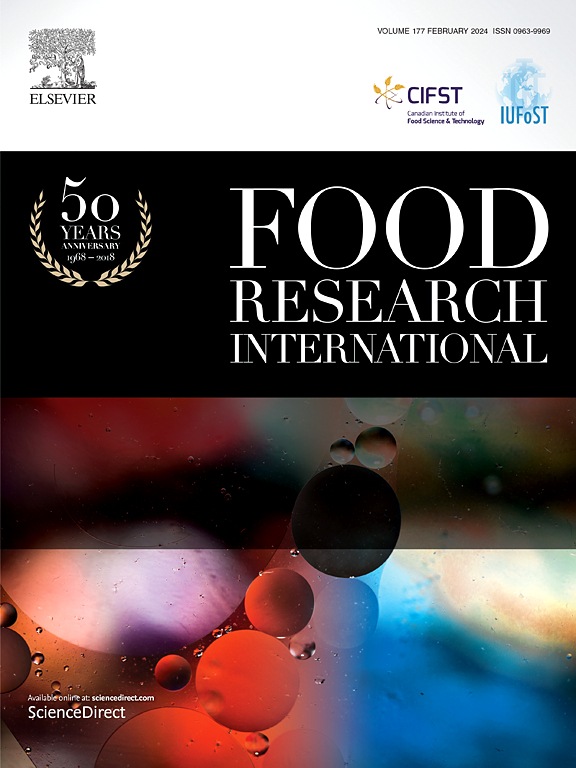切成薄片的胡萝卜和西葫芦中的肠炎沙门氏菌在较高的温度和相对湿度条件下存活得更好
IF 8
1区 农林科学
Q1 FOOD SCIENCE & TECHNOLOGY
引用次数: 0
摘要
在全球对即食食品需求增加的同时,与最低限度加工蔬菜(MPV)有关的沙门氏菌病疫情也出现了令人担忧的上升。研究了不同温度(6°C、9°C和12°C)和相对湿度(RH;流式细胞术分析肠球菌细胞的通透性和膜电位,扫描电镜观察细胞形态。建立了小肠沙门氏菌在微加工胡萝卜和西葫芦中存活的线性模型。胡萝卜(温度p≤2e - 16, RH p = 0.00107)和西葫芦(温度p≤2e - 16, RH p = 1.72e - 05)前24 h存活率调整后的R2系数分别为0.95和0.97。在剩余的贮藏时间(24 ~ 168 h)中,调整后的R2值仍然很高:胡萝卜为0.92(温度p = 2.76e−13,RH p = 4.15e−10),西葫芦为0.91(温度p = 1.24e−13,RH p = 2.72e−07)。这表明线性模型适合于描述肠球菌的行为。随着温度和相对湿度的升高,肠球菌膜通透性和细胞膜非极化程度降低。贮藏168 h时肠球菌的形态发生了显著变化。温度和相对湿度均影响微加工胡萝卜和西葫芦中的肠球菌存活率,较高温度和相对湿度条件下存活率较高。本研究中建立的模型可能有助于管理MPV中与肠球菌相关的微生物风险。本文章由计算机程序翻译,如有差异,请以英文原文为准。

Salmonella enterica in thinly sliced carrots and zucchini survives better at higher temperatures and higher relative humidity conditions
The global increase in demand for ready-to-eat foods has been accompanied by a concerning rise in salmonellosis outbreaks linked to minimally processed vegetables (MPV). This study evaluated S. enterica survival in minimally processed carrot and zucchini under different combined conditions of temperature (6, 9 and 12 °C) and relative humidity (RH; 75, 85 and 95 %) over 168 h. The permeability and membrane potential of S. enterica cells were analyzed by flow cytometry and cell morphology was evaluated by scanning electron microscopy. Linear models for survival of S. enterica in minimally processed carrot and zucchini were developed. The adjusted R2 coefficient values for survival in the first 24 h were 0.95 for carrot (temperature p ≤2e−16 and RH p = 0.00107) and 0.97 for zucchini (temperature p ≤2e−16 and RH p = 1.72e−05). The adjusted R2 values for the remainder of storage (24 to 168 h) remained high: 0.92 for carrots (temperature p = 2.76e−13 and RH p = 4.15e−10) and 0.91 for zucchini (temperature p = 1.24e−13 and RH p = 2.72e−07). This suggests that the linear model is suitable for describing S. enterica behavior. S. enterica membrane permeability and degree of non-polarization of cell membranes decreased as temperature and RH increased. S. enterica showed significant morphological changes at 168 h of storage. Both temperature and RH affect S. enterica survival in minimally processed carrot and zucchini, with better survival at higher temperature and relativity humidity conditions. The models developed in this study may be useful for managing microbiological risks associated with S. enterica in MPV.
求助全文
通过发布文献求助,成功后即可免费获取论文全文。
去求助
来源期刊

Food Research International
工程技术-食品科技
CiteScore
12.50
自引率
7.40%
发文量
1183
审稿时长
79 days
期刊介绍:
Food Research International serves as a rapid dissemination platform for significant and impactful research in food science, technology, engineering, and nutrition. The journal focuses on publishing novel, high-quality, and high-impact review papers, original research papers, and letters to the editors across various disciplines in the science and technology of food. Additionally, it follows a policy of publishing special issues on topical and emergent subjects in food research or related areas. Selected, peer-reviewed papers from scientific meetings, workshops, and conferences on the science, technology, and engineering of foods are also featured in special issues.
 求助内容:
求助内容: 应助结果提醒方式:
应助结果提醒方式:


